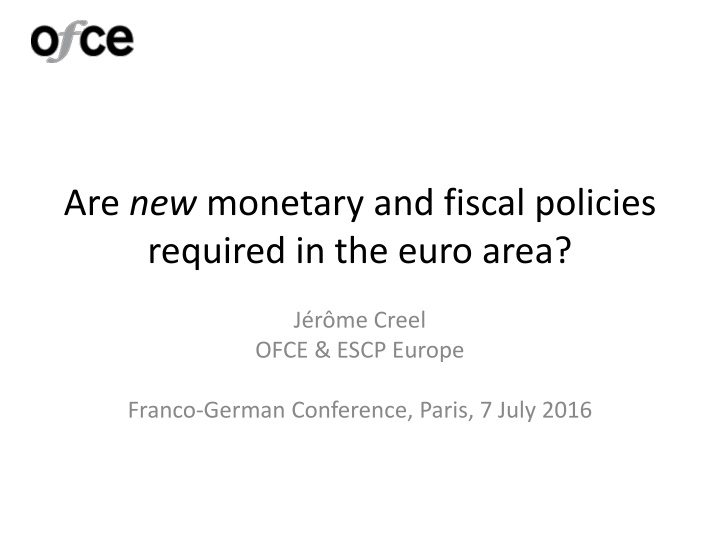
Monetary and Fiscal Policy Implications in the Euro Area
Explore the necessity of new monetary and fiscal policies in the euro area, examining the impacts of quantitative easing and the challenges of reconciling secular stagnation with core inflation. Delve into the risks associated with QE, consensus on macro effects in the US and UK, and effects in the euro area pre-2015, shedding light on the complexity of economic policy decisions.
Download Presentation

Please find below an Image/Link to download the presentation.
The content on the website is provided AS IS for your information and personal use only. It may not be sold, licensed, or shared on other websites without obtaining consent from the author. If you encounter any issues during the download, it is possible that the publisher has removed the file from their server.
You are allowed to download the files provided on this website for personal or commercial use, subject to the condition that they are used lawfully. All files are the property of their respective owners.
The content on the website is provided AS IS for your information and personal use only. It may not be sold, licensed, or shared on other websites without obtaining consent from the author.
E N D
Presentation Transcript
Are new monetary and fiscal policies required in the euro area? J r me Creel OFCE & ESCP Europe Franco-German Conference, Paris, 7 July 2016
Outline Secular stagnation, on the demand side New monetary policy? Why? QE has begun Impact of QE on investment, not so low Impact of QE on stock prices, not so high, if any New fiscal policy? Yes, please Fiscal leeway Adopting a golden rule of public finance
Shocking! (T)he results suggest that reconciling the secular stagnation hypothesis with the core inflation data is a challenge and may imply that policies aimed at stimulating demand should complement supply side policies in the economic policy mix. (Jarocinski & Lenza, 2016, ECB WP)
Monetary policy: what has happened? ECB QE s announcement Source: Wu & Xia (JMCB, 2016)
Many risks associated with QE Lack of liquidity for highly-demanded assets Lack of safe assets (for collateral purposes) Risks to financial stability Excess volatility on emerging markets Size of CB s balance sheet makes it hard to reverse the monetary stance CB independence & credibility undermined Delayed fiscal consolidation Distributional effects
Consensus on the macro effects in the US and UK Source: Reza, Santor & Suchanek, Bk of Canada WP, 2015
Effects in the euro area before 2015 Drawing on conventional & unconventional measures before QE, Creel, Hubert & Viennot (AE, forthc.) show that the interest rate channel has worked in France, Germany, Italy & Spain The argument of the impairment of this channel to promote QE is misleading the effectiveness of unconventional measures depends on the instrument (EL, LTRO, SHMPP), the market (sovereign at different maturities, credit to NFC, housing) and the targeted variable (interest rate or new volumes)
Effects in the euro area, including QE A foreword: uneven investment paths in the euro area Source: Eurostat
Effects in the euro area (cnd) Impact of ECB MP on investment (counterfactual) Sample for estimation: 1999Q1/2015Q4. Data sources: Eurostat, ECB & Datastream without unconventional MP without MP ?? + ?? 1 ???= 0.086 0.04 ??? 1 0.023 0.00 .?????? 1 0.035 0.00 .? ????? 1 0.151 0.00 .??????????? 1+ 2.09 0.07 0.214 0.14 + 0.03 0.00 It 1+ 0.138 0.08 It 2+ 1.108 0.31 . ? ????? 2 VAt 1 0.006 0.00 CURt 1 Source: Blot, Creel, Hubert & Labondance, 2016, EP Monetary Dialogue . ? ????? 1+0.006 0.00
Effects in the euro area (cnd) ER Stock prices Data sample: Mar03 - Mar16 Source: Blot, Hubert & Rifflart (Revue de l OFCE, 2016) NB: with a large EA current account surplus, not surprising that UnConv-EUZ does not impinge on /$ ER neutral effect, at best, could be expected
Effects in the euro area (cnd) Distributional effects of MP Literature: inconclusive so far Doepke & Schneider (JPE, 2006) report that higher inflation reduces income inequality in the US (debtors vs. savers) Saiki & Frost (AE, 2014) report that unconventional MP increases income inequality in Japan (portfolio channel) Using a VAR on euro area data, IRF of a restrictive MP shock gives: VAR [UR, hours, IP, new credits, CPI, IR, CISS, /$, Oil,2-y inf, 5-y inf, shadow rate], sep 04 jan 15 Source: Blot, Creel, Hubert, Labondance & Ragot, 2015, EP Monetary Dialogue
Fiscal policy It has been back! Many questions, still On-going discussion about the value of fiscal multiplier over the cycle Barnichon & Matthes (CEPR WP, 2016): multiplier larger in recessions only because contractionary multiplier larger during recessions High deficits since GFC have produced large debts Crowding-out or crowding-in? Ricardian or non-Ricardian consumers? Should fiscal austerity continue? Should another set of fiscal rules be applied?
Dealing with austerity with iAGS model iAGS for independent Annual Growth Survey Reduced-form model Multi-country model (currently 11 EZ members) Interdependencies are captured by external (intra)trade and by common monetary policy Prices are represented by a Phillips curve A Taylor rule defines the stance of monetary policy Non-linear (time-varying) fiscal multiplier: high in recessions, low in booms Hysteresis effects
The costs of further consolidation NB: remember the risks with QE. Here (with iAGS) delayed consolidation is better (lowest output gap) Source: iAGS 2016
A golden rule of public finance? Net public investment exempted from SGP rules and the Fiscal compact The pros: economically sensible; fiscal leeway; end of sharp net investment decrease; potentially positive for potential output The cons: crowding-out; incentivising tangible assets at the expense of intangible assets; creative accounting bias; debt increase
Net investment in the euro area Sources: European Commission & Truger (IMK WP 2016)
Impact of a golden rule Truger (2016) argues that the golden rule would quite substantially improve the real economy
Impact of a golden rule (cnd) In an augmented New Keynesian model, Creel, Hubert & Saraceno (JEDC 2013) show that the golden rule performs (significantly) better than the fiscal compact or the 3%-rule (status quo)
Conclusion No new MP required, but the pursuit of QE Change of fiscal rule (pro-investment) to: benefit potential output boost demand and prices under low inflation increase public bond s supply under high demand (or finance new public investment with eurobonds?) increase (future) interest rates under ZLB Possible? Under close cooperation btw gvts & the ECB The theoretical background exists: Leeper (1991) The most challenging issue would be to target public inv. impacting potential output Micro issue and political economy issue




